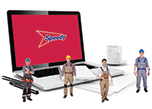Guide to working safely with cement
Cement is a binding agent, which sets and therefore adheres different materials to each other. It is often mixed on sites and on DIY jobs using a cement mixer.
As well as being easy to work with, it is fairly inexpensive and extremely durable. Cement can also be used to create concrete, which is when sand, gravel or crushed stone - also known as aggregates - are added to a mixture of water and cement.
Its properties mean most construction companies will work with it at some point. But it can be hazardous if not used or worked with correctly.
The HSE states that all sites and cement users must follow the Assess, Control, Review model:
- Assess and identify where it will be used, when, what for and who will be using it
- Control its use. Ensure it remains only where needed, and that it is used properly. Wear the correct PPE and take precautions
- Review its use. Constantly monitor and oversee its use and keep health documentation up to date, as well as an incident log.
How to work safely with cement
As with many aspects of working on a building site, dealing with cement and concrete is not without its risks. Protective equipment is required and workers need to be properly trained to prevent incidents involving both themselves and other employees.
1. Protect your face & skin
Cement, as mentioned, is designed to adhere to surfaces. If it came into contact with skin, not only is it hard to get off, but it could also cause irritation and potentially burns. Wet cement has a pH of 12 to 13.8, which is highly alkaline. In the long term, contact will increase the skin's sensitivity and inflammation, and can also cause it to sag or wrinkle.
Prolonged contact will make these worse. A serious burn or ulcer can worsen if trapped under clothing or not treated ASAP and can cause life-changing injuries. Cement can also cause dermatitis.
Protect your skin by wearing clothing which covers all exposed skin, such as arms and legs, to avoid cement splashing onto the skin. Protect clothing with disposable covers if required, and always wear gloves.
You should also wear a mask and eye protection to avoid inhaling any of the cement or causing any getting into your eye. Even just rubbing your eye could cause irritation. If working on a site, a hard hat is also necessary.
Wash off any cement on the skin as soon as possible. Employees should ensure there are suitable washing facilities on site, from sinks large enough to wash forearms to shower facilities if there is a risk of full skin contact with cement. Soap and hot and cold running water should be available.
2. Be aware of the weight
Cement is very heavy, even before it has set. When lifting cement, remember that it is just like any other heavy material; your back should be straight, your legs bent, and the weight between your legs as close to the body as possible.
Cement should always be pushed and not lifted into its designated end place, too.
3. Ensure everybody is trained to use the machinery
Hiring a cement mixer? Ensure that everyone who operates the equipment knows what they are doing.
When you hire anything from Speedy, it will come with operating instructions and safety guidance. It will also have been checked over since it was last hired out. But it is your responsibility to follow this guidance and be safe around cement and all other equipment on a site.
As for the actual cement, users should know the risks, know to wear the correct PPE and understand how to safely use mixed cement (including setting times and contact).
- 2024
- 2023
- December 2023 (13)
- November 2023 (9)
- October 2023 (7)
- September 2023 (10)
- August 2023 (20)
- July 2023 (21)
- June 2023 (17)
- May 2023 (17)
- April 2023 (17)
- March 2023 (14)
- February 2023 (15)
- January 2023 (7)
- 2022
- December 2022 (6)
- November 2022 (12)
- October 2022 (24)
- September 2022 (14)
- August 2022 (12)
- July 2022 (15)
- June 2022 (18)
- May 2022 (14)
- April 2022 (9)
- March 2022 (5)
- February 2022 (5)
- January 2022 (2)
- 2021
- December 2021 (7)
- November 2021 (10)
- October 2021 (1)
- September 2021 (1)
- August 2021 (3)
- July 2021 (3)
- June 2021 (4)
- May 2021 (1)
- April 2021 (1)
- March 2021 (2)
- February 2021 (1)
- January 2021 (1)
- 2020
- 2019
- 2017
- 2016
- 2014
- 2013
- 2012
- 2011


